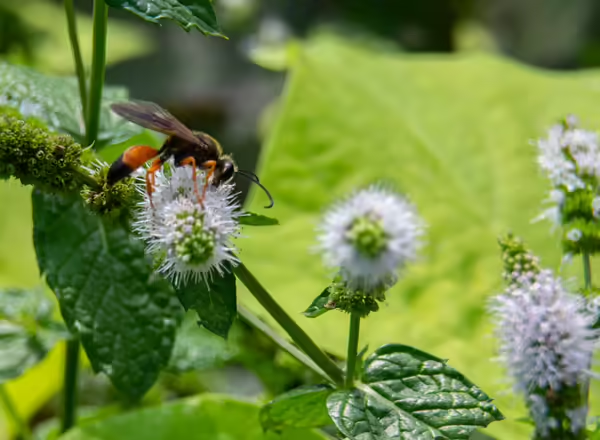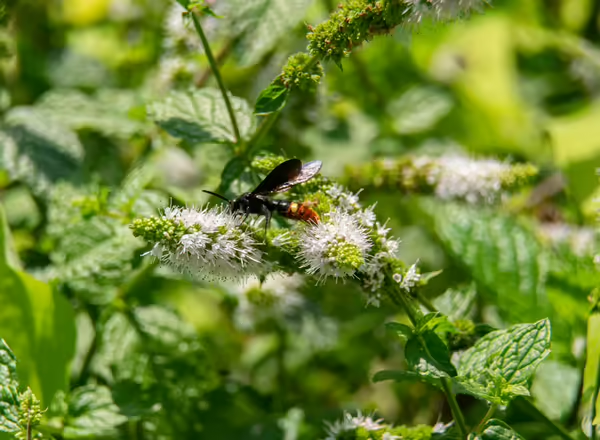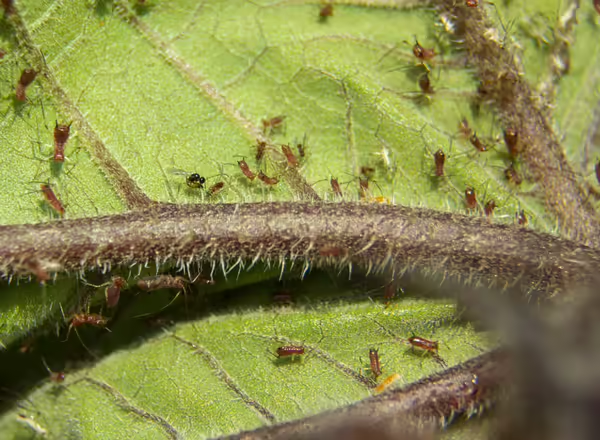
Mention wasps to someone, and you’ll likely get a negative reaction. Wasps are often seen as scary, angry insects that are dangerous and likely to sting. While some wasps can be aggressive at times, and some pack a powerful sting, they are good insects to have around. They are the unsung heroes of our landscapes.
Why do wasps get a bad name?
As with many things, one individual (or group) ruins things for everyone, and wasps are no exception. There are around 103,000 described species of wasps in the world. Of these, 33,000 are considered stinging (aculeate) wasps. About 1,000 of these stinging wasps are social, think yellowjackets, baldfaced hornets, and paper wasps. These are the wasps that give the entire group a bad name and are also the ones we most commonly interact with.
While out foraging, social wasps aren’t particularly aggressive. That all changes when nests are involved. Social wasps, particularly yellowjackets, are notorious for aggressively defending their nests, which can result in painful stings for those who venture to close or disturb their nests. But it’s not just wasps that will do this; social bees, like honey bees, and ants, will also defend their nests from perceived threats.
So why do wasps get a worse name than other singing insects? Is it because their stings are, on average, more painful? Or is it because we don’t recognize or are unaware of the benefits they provide like we do bees?
The benefits of wasps
Pollinators
Bees get most of the attention when it comes to pollinating insects, but wasps also act as pollinators. While the larva of most wasps are carnivores (gall wasps would be an exception), the adults feed on sugars (this is why you commonly see wasps around sugary drinks, especially in the fall), often in the form of nectar. While feeding on nectar, wasps may also pollinate flowers. In some cases, wasps can be as efficient at pollinating as bees and can take the place of bees.
Predators
Wasps are vital for controlling insect populations in our landscapes. Social wasps will capture a wide variety of insects (generalist predators), including flies, caterpillars, and beetles, chew them up, and feed them to larva.
Solitary wasps tend to be a little more focused on what they feed their young, often attacking one type of insect. For example, great golden digger wasps and great black wasps will paralyze katydids, grasshoppers, and crickets and bring them to their burrows as food for their young. Others, like the blue-winged wasp, will dig into the ground to paralyze and lay eggs on grubs like those of green June beetles.
Parasitoid wasps are also incredibly important in controlling insect populations. Most parasitoid wasps are small; you would probably confuse them for a gnat. They may only attack one type of insect, like caterpillars, or in some cases, one species. They will attack various insects, including aphids, whiteflies, mealybugs, caterpillars, and insect eggs. After consuming their host, the larvae will pupate, and adult wasps will emerge and lay eggs in new hosts.
Food
Wasps can also serve as food for other organisms. Birds such as crows, orioles, bluebirds, sparrows, and chickadees may eat wasps as part of their diets. Other birds, like the summer tanager, specialize on bees and wasps. Mammals like bears, skunks, and occasionally raccoons will dig up yellowjacket nests and feed on the larvae. Wasps can also fall prey to other insects like praying mantids, dragonflies, robber flies, and other wasps. In many parts of the world, wasps (and other insects) serve as food for humans too.
Seed dispersal
Some plants rely on insects to disperse their seeds, often ants. The seeds of these plants have an elaiosome, which are fleshy structures are full of fats. The insects will feed on these and disperse the seeds. In North and South Carolina, researchers have found that yellowjackets play an important role in the dispersal of Trillium seeds.
Why are there so many wasps in the fall?
In the fall, wasps, particularly yellowjackets, may become unwelcome guests at outdoor activities, but all they want is something to eat. As fall approaches and progresses, many plants stop blooming, reducing the amount of food available for yellowjackets (and other social wasps). Additionally, nests may contain thousands of workers. Because of this lack of food, and the large number of wasps, they will begin searching for food, and they are attracted to sweet food items such as carbonated beverages, juices, candy, and fruit.
To help avoid any issues with wasps, place beverages in cups when you are outdoors so you can see what you are drinking. If a yellowjacket decides to check you out, blow on it or brush it away rather than swatting at it (which will commonly result in you getting stung). Providing fall-blooming plants, such as goldenrods and asters, can provide alternate food sources, so maybe they won’t need to visit your picnic.
While wasps can be annoying and painful at times, their benefits far outweigh their drawbacks.
Good Growing fact of the week: Stingers of wasps (as well as bees and ants) are modified egg-laying devices (ovipositors). Since only females lay eggs, only females have stingers and are, therefore, capable of stinging.



Resources and for more information:
Bale, Megan T., Jennifer A. Zettler, Bradford A. Robinson, Timothy P. Spira, and Craig R. Allen. 2003. “Yellow Jackets May Be an Underestimated Component of an Ant-Seed Mutualism.” Southeastern Naturalist 2 (4): 609–14.
Brock, Ryan E., Alessandro Cini, and Seirian Sumner. 2021. “Ecosystem Services Provided by Aculeate Wasps.” Biological Reviews 96 (4).
Eaton, Eric R. 2021. Wasps : The Astonishing Diversity of a Misunderstood Insect. Princeton, New Jersey: Princeton University Press.
Hallett, Allysa C., Randall J. Mitchell, Evan R. Chamberlain, and Jeffrey D. Karron. 2017. “Pollination Success Following Loss of a Frequent Pollinator: The Role of Compensatory Visitation by Other Effective Pollinators.” AoB PLANTS 9 (3).
Sumner, Seirian, Georgia Law, and Alessandro Cini. 2018. “Why We Love Bees and Hate Wasps.” Ecological Entomology 43 (6): 836–45.
Signup for our emails! Want to get notified when new Good Growing posts are available? SIGN ME UP
Give us feedback! How helpful was this information (click one): Very helpful | Somewhat helpful | Not very helpful
MEET THE AUTHOR
Ken Johnson is a Horticulture Educator with University of Illinois Extension, serving Calhoun, Cass, Greene, Morgan, and Scott counties since 2013. Ken provides horticulture programming with an emphasis on fruit and vegetable production, pest management, and beneficial insects. Through his programming, he aims to increase backyard food production and foster a greater appreciation of insects.